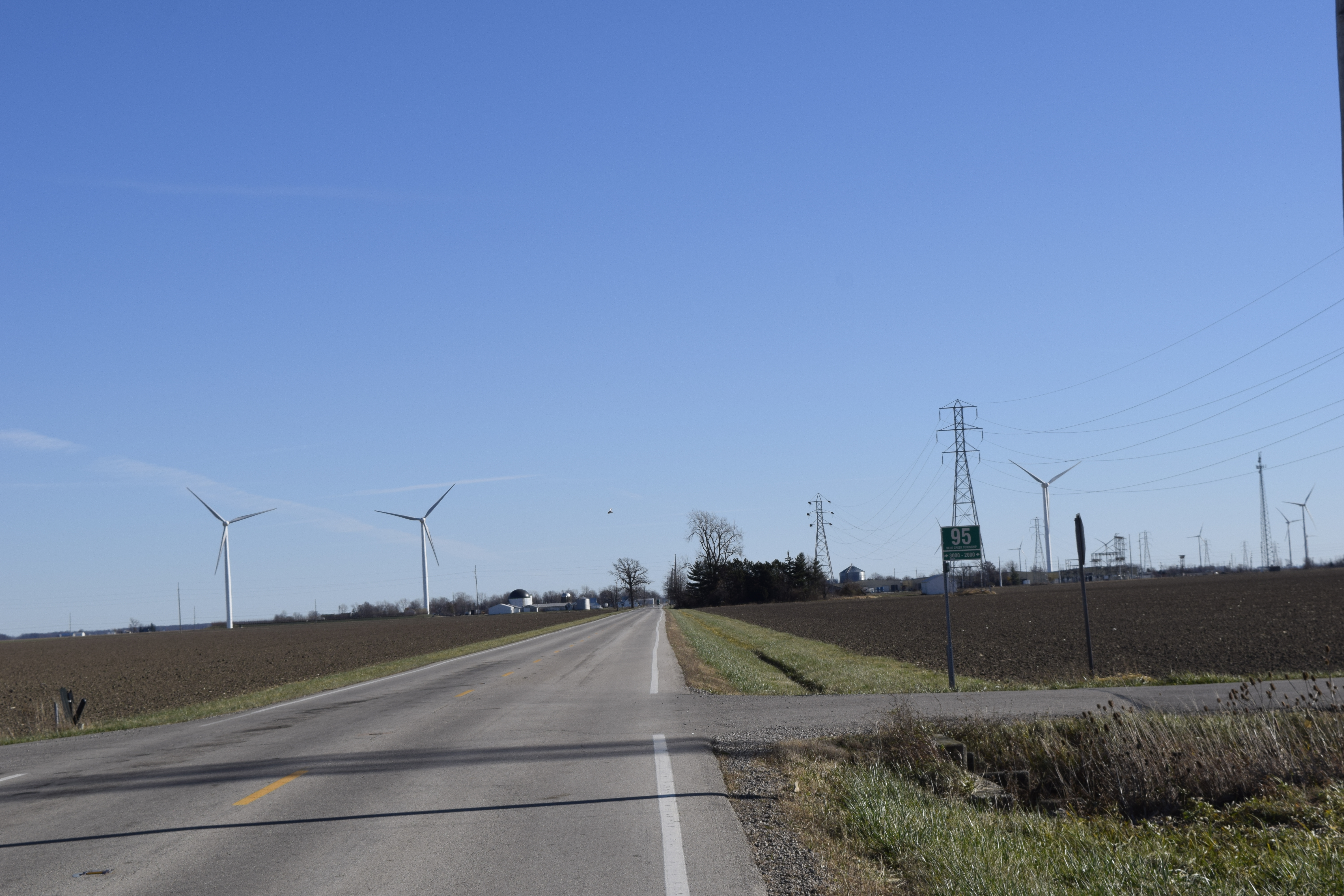SITE PATH
ONE ENERGY FEED

SUBSCRIBE
CONNECT WITH US
News Filters

Think you solved our scholarship scenario? Find out in today’s Wind Study answer!
On Monday, we asked you to figure out the total amount of Megawatt Scholarship money awarded through 2020 and to develop an equation to figure that total in any given year. If you arrived at the correct answer, you’ve got some real accounting expertise!
Download the homework answer here and check your math!
And be sure to share this educational series Facebook and Twitter.
For more information on Megawatt Scholarships, head to www.megawattscholarships.org.


Sexy. The 1986 edition of Webster’s Third New International Dictionary gave two definitions of sexy: “1. spicy or racy with references to or portrayals of sexually stimulating matter” and “2. sexually suggestive, erotically stimulating.” Since then, Merriam-Webster has added “genuinely attractive or interesting” to the definition and gives the example of “a sexy stock.” Other dictionaries include terms like “exciting” or “glamorous.”
Somewhere along the way, “sexy” morphed its way into the business world as being synonymous with “investment-worthy.” Sexy businesses (not to be confused with sex businesses, the definition of which really hasn’t changed in thousands of years) attract investors and generate buzz. They are where the press focuses attention and where social media posts explode – and the money follows.
I wonder how long this definition of sexy can be sustained. If we only focus on the sexy things, what happens to the decidedly un-sexy necessities? What happens to the basics that societies need to survive and thrive? Infrastructure isn’t sexy, but we all use it every day. Electricity isn’t sexy, but no one is happy when the power goes out. Sustainability isn’t sexy, but climate change requires our attention. Equitable economics isn’t sexy, but bringing people out of poverty is a must.
Maybe we need to shift our interpretation of what is sexy so that we can dedicate the time, energy, and capital to efforts that can truly sustain our society and our planet – towards efforts that solve real, immediate, critical world problems.
There is no doubt that “decarbonization of the distributed power grid” is not listed in Roget’s Thesaurus under “sexy.” But it’s extremely important, and it’s what we do at One Energy. We focus on the .6% of U.S. electricity consumers who account for 26% of the consumption of electrical power, and we provide solutions that can dramatically reduce their carbon footprint. We do it as a business that meets 10 of the United Nations’ 17 Sustainable Development Goals. We do it with an executive team that’s 80% women, in a stunning, light-filled, collaborative workspace that promotes health and wellness in multiple ways. We do it while treating our people well. We are focused every day on doing the right thing for our customers, our investors, our people, and our planet. It is incredibly exciting stuff, but it’s definitely not glamorous.
Is One Energy sexy by current standards? I certainly think it is. Tackling the big problems. Treating employees well. Reducing the carbon footprint. Doing the right thing. Maybe we could start to define “sexy” in a different way. I’ll reach out to Merriam-Webster.
Anne Bain is the Head of Accounting at One Energy.

This week’s Wind Views photo features a Wind for Industry project located in Findlay, Ohio. The two 405-foot turbines (measured from tower base to blade tip) together provide up to 3.0 MW of electricity to directly power a local manufacturing facility.
At One Energy, we value the communities where we install Wind for Industry projects. And our wind turbines represent our customers’ commitment to these communities as well.
One example of this commitment to community is the Megawatt Scholarship program. For every One Energy turbine installed, one $5,000 scholarship is awarded every year to a graduating senior in the community. That means $100k in scholarships are available to the Class of 2021!
Visit www.megawattscholarships.org to learn more about eligibility requirements and to apply! Applications are due March 6.
And be sure to share on Twitter, Facebook, and Instagram!
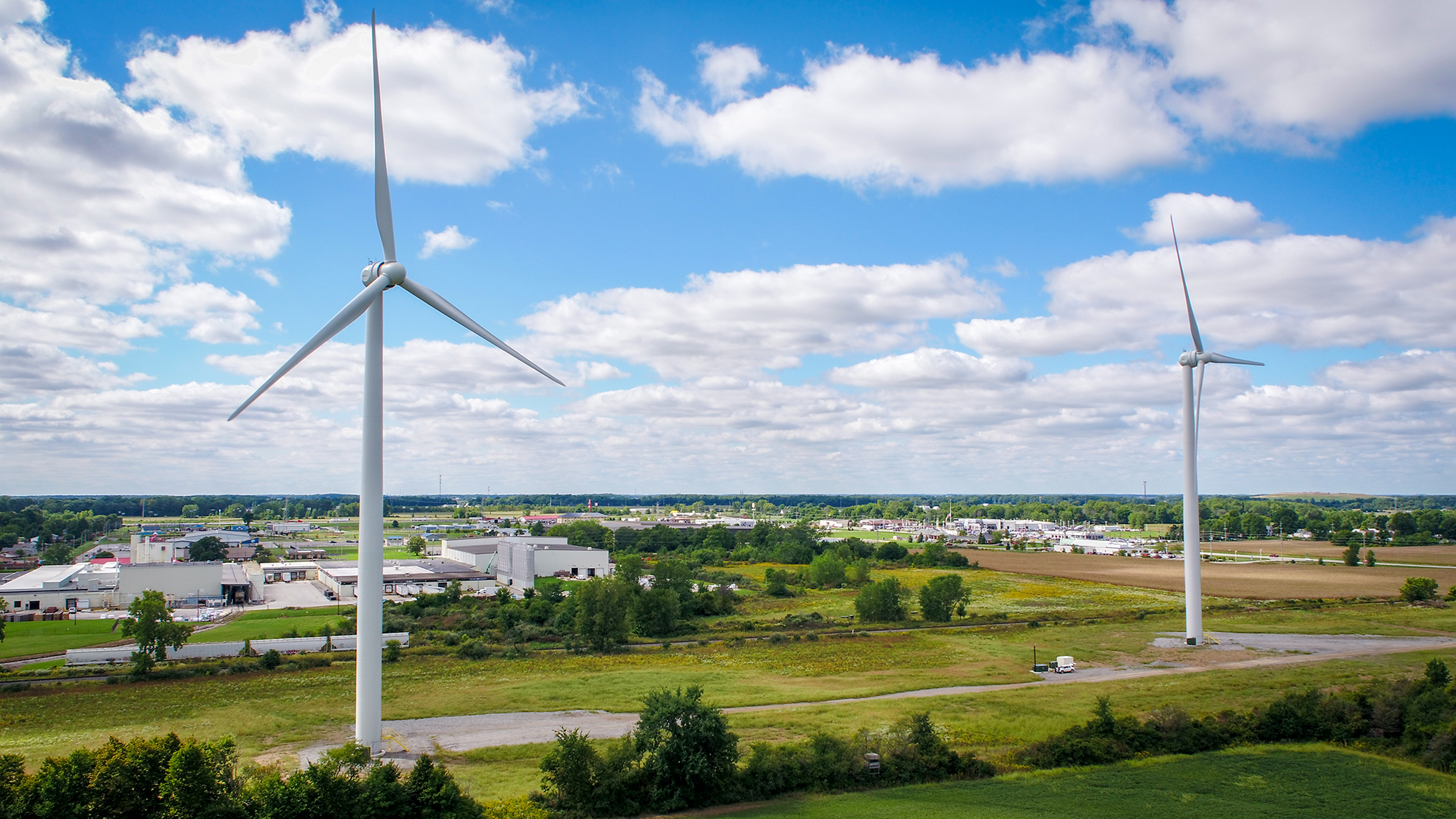
DCIM101MEDIADJI_0004.JPG

Through our Megawatt Scholarship program, One Energy and participating customers award $5,000 per turbine per year to local students pursuing 2- or 4-year degrees in science, technology, engineering, and math (STEM) fields. And with the amount of projects we’ve installed, that’s a lot of scholarship money to keep track of!
Help us track these funds for this week’s Wind Study homework! 🔗 Download the questions here and check back Friday for the answer.
You can also find this educational series on Facebook and Twitter.
For more information on Megawatt Scholarships, head to www.megawattscholarships.org.
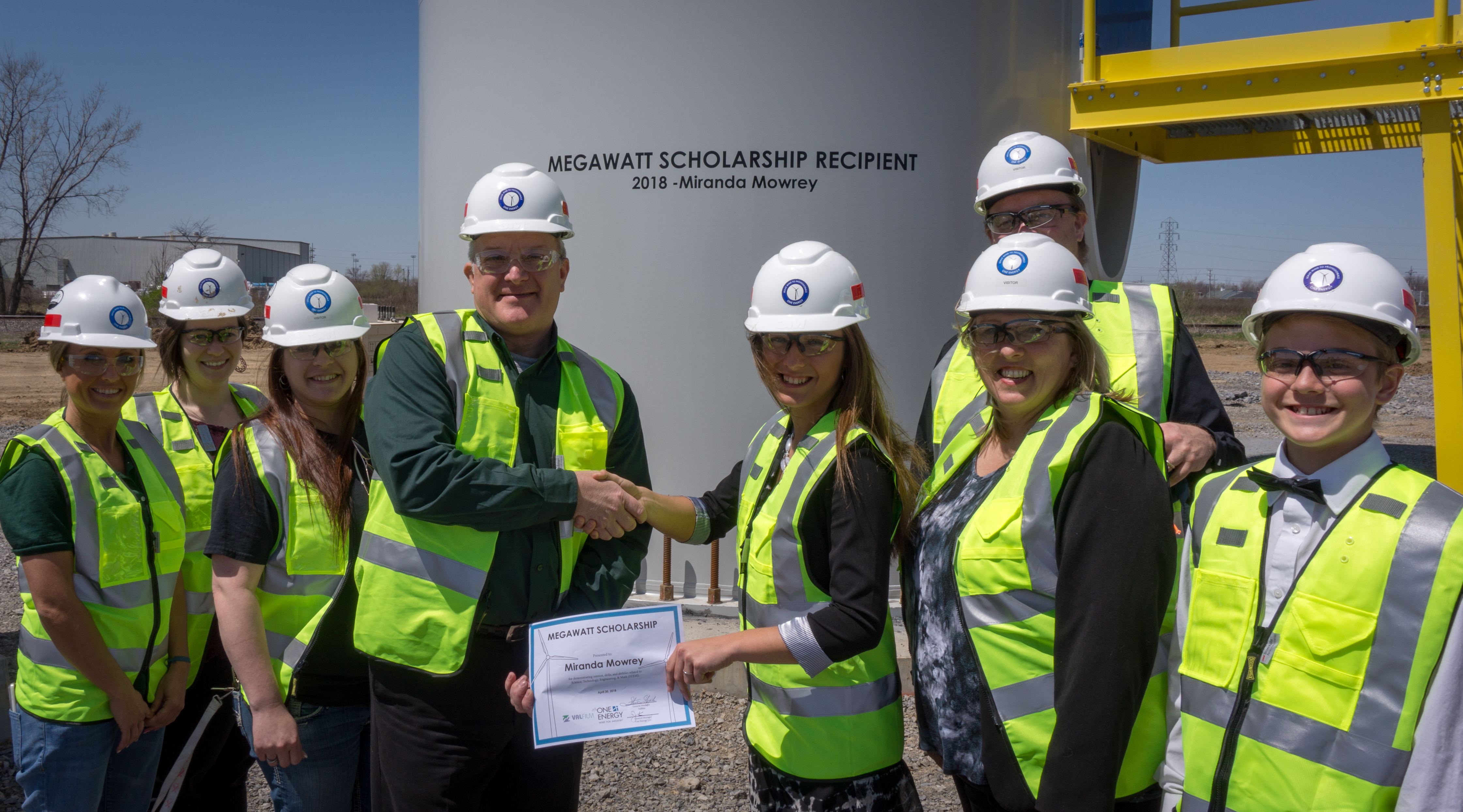

One Energy collects information about wind in order to properly build and operate wind projects – but just how is this information collected?
Last Science Shorts, Project Engineer Ben introduced you to the North Findlay Wind Campus weather station and MET Pole, which use wind instrumentation to measure weather and climate data. Now, Head of Project Planning and Technology Jessica is taking a deep dive into how some of these tools actually work!
In this episode, Jessica is focusing on anemometers, which allow One Energy to measure the most important data we collect: wind speed data!
Watch and learn as Jessica covers both cup anemometers and sonic anemometers – their functions, uses, differences, and related equations. Then come back for the next Science Short to learn about the third instrument we use: LiDAR units!
Subscribe to our YouTube channel and don’t miss any future Science Shorts!
And be sure to share this educational series on Facebook and Instagram!

Are you cut out to work for a wind turbine manufacturer? Find out in today’s Wind Study answer!
On Monday, we asked you to play the role of turbine manufacturer and calculate the power curve of a wind turbine. If you arrived at the correct answer, we could use your work to plan this hypothetical wind energy project!
🔗Download the homework answer here and see if this is a career path you should consider.
You can also find this educational series on Facebook and Twitter.
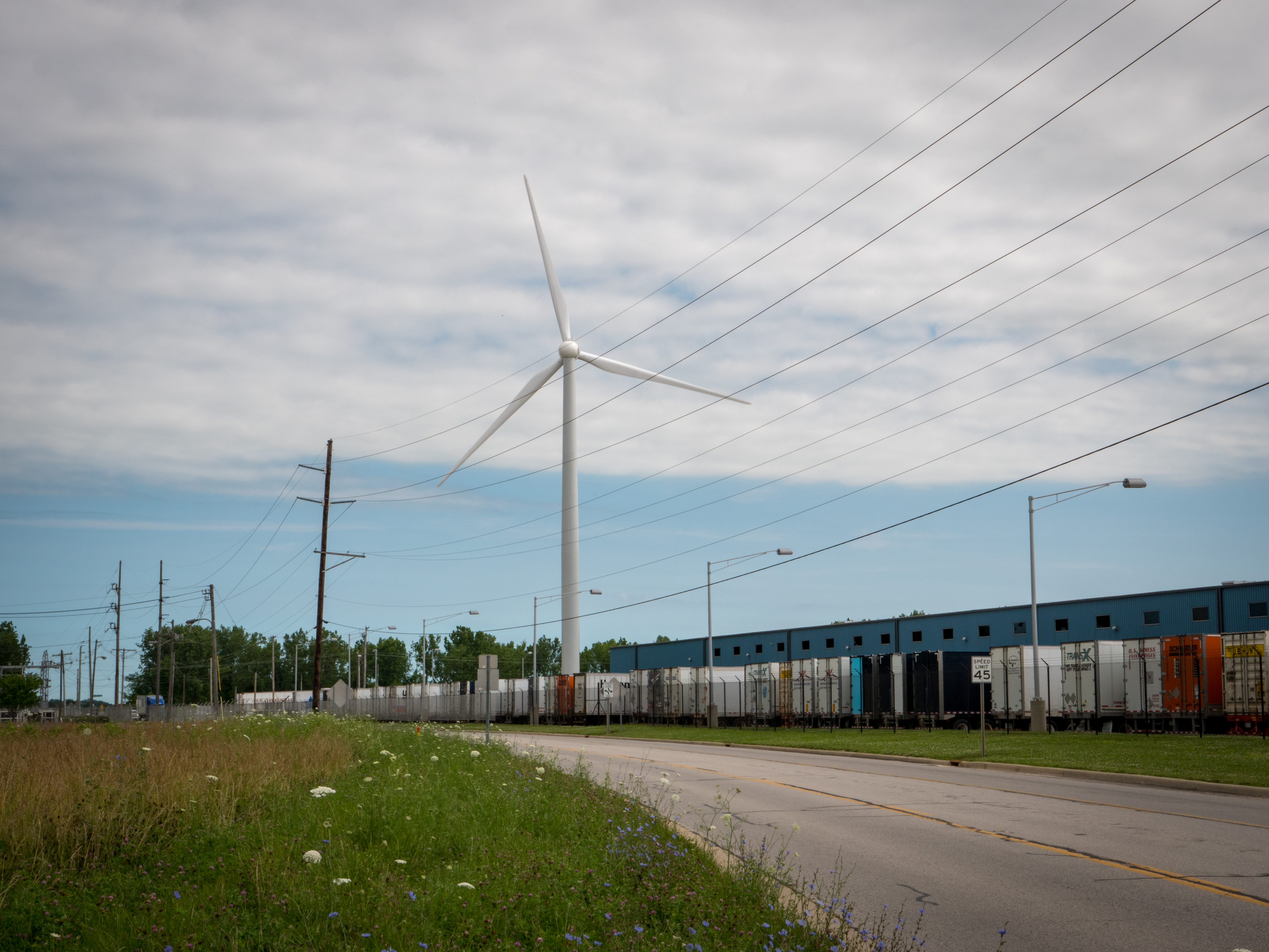

There is a phrase that resounds across the construction industry: “good help is hard to find.” The world has become more automated, more focused on technology, and less dependent on hands-on work. It’s only natural that the workforce has likewise gravitated away from skilled labor and moved towards technology-based educations. As the divide between skilled laborers and engineers increases, expertise suffers within the industry. Tensions are created between skilled labor and engineering disciplines, often causing a dysfunctional self-perform construction team. So, the million-dollar question is, how can this gap be bridged?
Individuals who want to work outside, who enjoy working with their hands, and who are not interested in what college may offer (including the associated costs), may choose to get a jump start on their career. Whether they decide to join an apprenticeship or find a job right out of high school, these individuals immediately make an income and gain relevant field experience. They learn practical applications for the entirety of their career, but they don’t always have a strong background in the fundamental engineering principles upon which construction is based.
On the other hand, individuals electing to go the academia route often learn about complex concepts and theoretical applications for field practices. When it is time to graduate, very few of these students have gained hands-on construction experience, but they walk away with a college degree and proof that they can understand complex principles. Often these students are saddled with a choice between finding work as an engineer or as a manager, developing people and projects. Either choice immediately places them in a sophisticated role within a company.
The paradoxical relationship that is shared between skilled laborers and engineers in construction creates room for animosity to build. They must work together seamlessly but are treated differently. In an ideal world, both groups would be cross-trained and would work together as a team.
Here at One Energy, we have cross-trained many of our skilled laborers and engineers to share duties and responsibilities. Here are some of our suggestions to start mending the gap for a self-perform construction team:
- Create ways to cross-train – One Energy rotates engineers through different departments of the company. One of the longest rotations is participating in 1-2 project lifecycles as a technician within a construction team. One Energy also regularly puts together engineering-based trainings for technicians, which teach conceptual theories.
- Encourage team camaraderie – a technician and an engineer are on the same team. A victory is never about the person or even the role, but rather the team.
- Create an environment for team building – getting to know the people you work with is something undervalued in the working world. Ensuring that work is a collaborative safe place where team members can work together will promote opportunity from within your business. Hold regular all-hands meetings, after work events, celebrations for company wins and individual successes to promote the team.
- Get out of the comfort zone – Technicians should participate in solving engineering problems and engineers should be trained on tools and equipment. Knowing what it is like on either end of the spectrum is invaluable to developing future leadership.
- Treat both roles the same – If a new engineer joins the team, their day starts and ends at the same time as a technician. If there is a new technician, ensure that they too will be trained on computer-based technology.
- Get (and give) feedback regularly – there can be a lot of emotions when it comes to someone’s career and personal growth. Be sure the lines of communication are open to talk through the program, and things that are (and are not) working well.
- Promote fairly and honestly, based on value to the company – this is perhaps the biggest takeaway. Some skills are more valuable than others, depending on the business model. Recognize what those skills are and monetize them effectively.
- Incentivize employees with equity – employee-owned businesses engage team members and encourage success for the business, rather than the individual. This is a great way to navigate potential silos within a business.
- TRAIN! Prepare your team to solve the unknown problem.
With a more cross-functional team, expertise develops organically. To have a skilled laborer that understands engineering fundamentals or an engineer with the ability to perform hands-on work creates an extremely resilient workplace.
While it may be true that “good help is hard to find,” it is not impossible to develop your own team of experts.
Chelsea Bumb is the Head of Construction at One Energy.

Safety is more than just following the rules. As One Energy CEO Jereme Kent explains, many construction companies experience common safety issues in the field because “it’s the system that’s broken.”
In today’s Safety Minute, Jereme introduces a new series exploring common safety problems in wind energy construction. At One Energy, we believe the first line of safety is engineering controls – and we’ll share how One Energy has put this belief into practice, to address known safety risks before employees head to the field.
In future episodes, we’ll take a deeper dive into the most common safety issues, sharing One Energy’s approach to fixing systems that has failed field teams in the past. Together, we can make the field – and the wind industry – safer from the ground up.
Watch the video below, and be sure to subscribe to our YouTube channel so you don’t miss a minute.

Attaching the rotor (hub + three blades) to the generator during wind turbine construction involves special crane rigging that allows the assembly to be lifted and guided mid-air.
Throughout this process, which we call the rotor fly, the rotor pivots mid-air and is raised up and over the top of the tower, where it will then be aligned with the generator and bolted into place.
As you can see in this photo, one blade is behind the tower, on the opposite side of the generator, where the rotor will eventually attach. Getting it to the correct side is where special maneuvering comes into play – as the rotor is lifted above the whole structure, shifted forward, and lowered to the proper height. Taglines work with the crane and tower crew to align the rotor and control the load during the pick.
At this point, it’s ready to be “caught” or guided into place with the help of technicians up-tower, who will complete the bolting. The use of alignment pins also helps ensure the rotor is installed correctly and safely.
This carefully coordinated procedure marks the final step of wind turbine erection!
To make sure you don’t miss this upcoming feature, follow us on Twitter, Facebook, and Instagram!
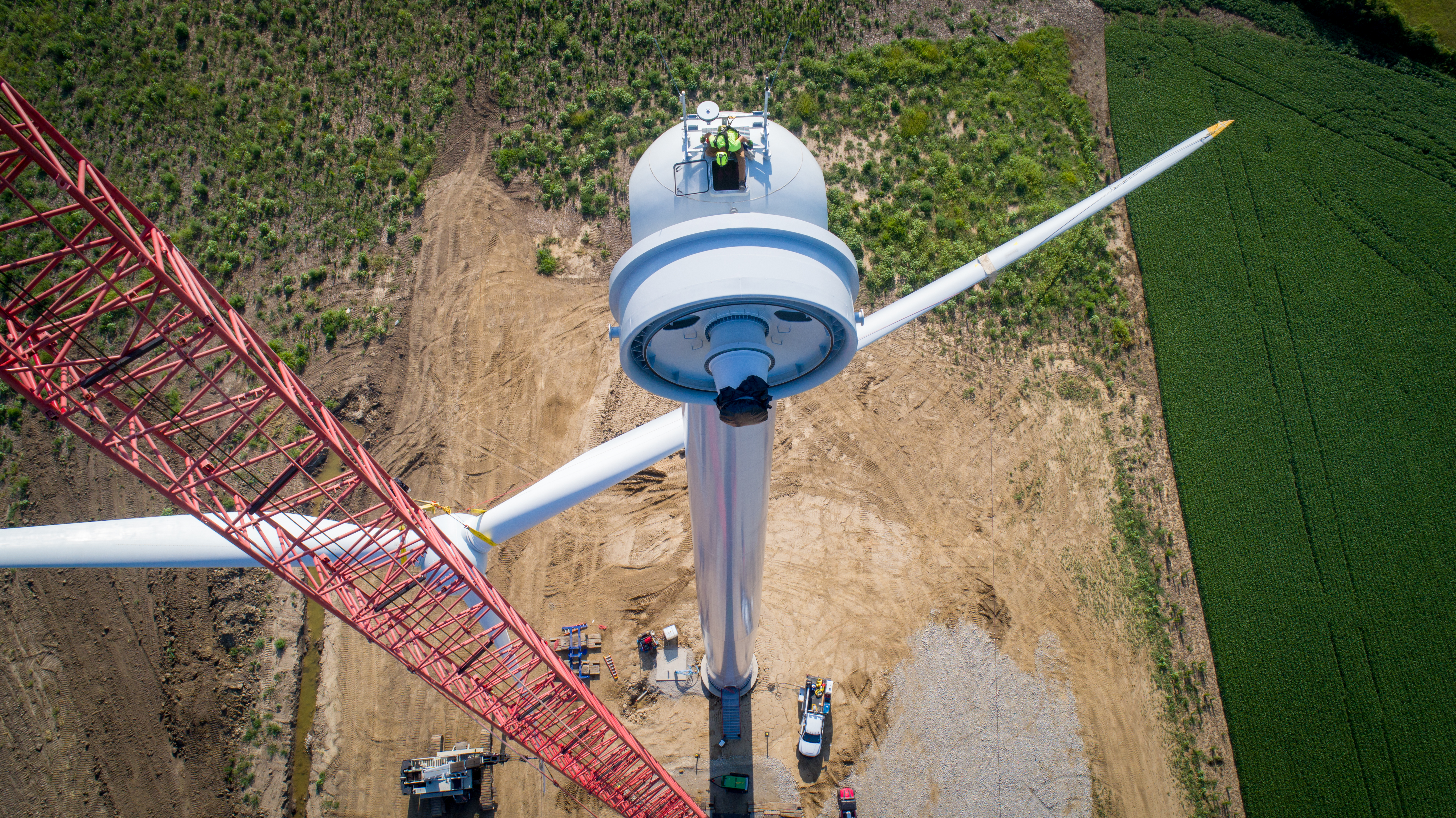

In this week’s Wind Study, you get to play the role of wind turbine manufacturer!
When planning a Wind for Industry project, One Energy tells the customer how much of their facility’s power will likely be produced by the wind turbines we install at their location. To do this, we use what’s called the turbine power curve. Power curves are governed by the design of the turbine and are provided by its manufacturer.
As the manufacturer of this fictional wind turbine, we need YOU to plot the power curve on the graph provided in today’s homework. Then use the accompanying equation to calculate the power produced at a given wind speed.
🔗 Download the homework questions here.
And check back Friday to download the answers and see if you’re cut out to manufacture wind turbines!
You can also find this educational series on Facebook and Twitter.
